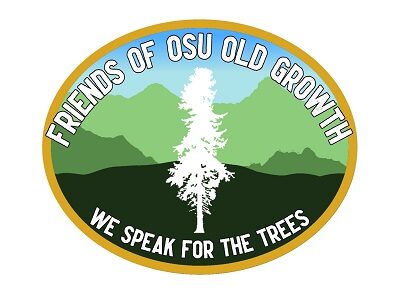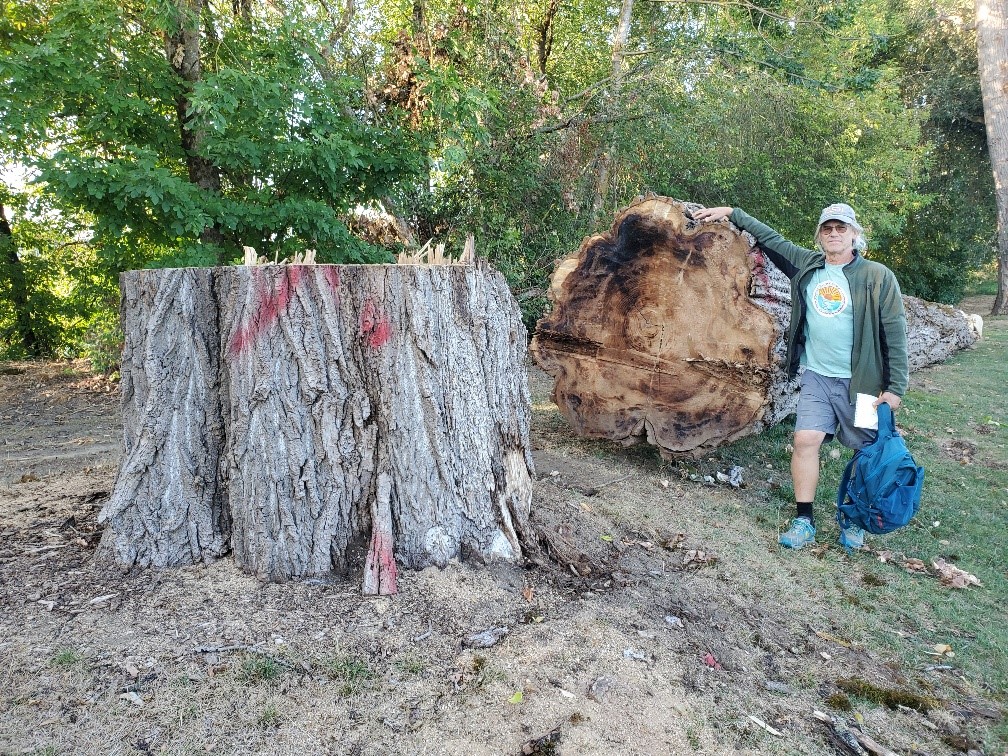
Old-Growth Cottonwoods Cut Down – Again: OSU professor emeritus Dr. Robert Beschta and forest ecologist Dr. J. Boone Kauffman are fuming, after discovering that managers of OSU’s Trysting Tree Golf Course have once again cut down old-growth cottonwoods. More than a year ago, they first called attention to the ecological importance of these ‘keystone species’ trees, urging golf course managers to stop cutting them. Many of the trees are located within the Willamette River Greenway, a protected zone on the western edge of the course. Development within the Greenway has been regulated under Oregon law for more than four decades. It now appears the professors’ earlier concerns were dismissed, as additional trees (both on the course and along the riverbank) have recently been cut.
Dr. Kauffman and Dr. Beschta claim the tree-cutting violated important wildlife and riparian protections – stipulated by law and the conditions granted for development and operation of the golf course. As experts with over 90 years of experience in riparian forest ecology and management, they know what they are talking about. Dr. Kauffman specializes in riparian studies and has traveled around the world researching forest ecosystems. Dr. Beschta is perhaps best known for his ground-breaking research on the importance of predators in maintaining healthy riparian habitats in Yellowstone National Park.
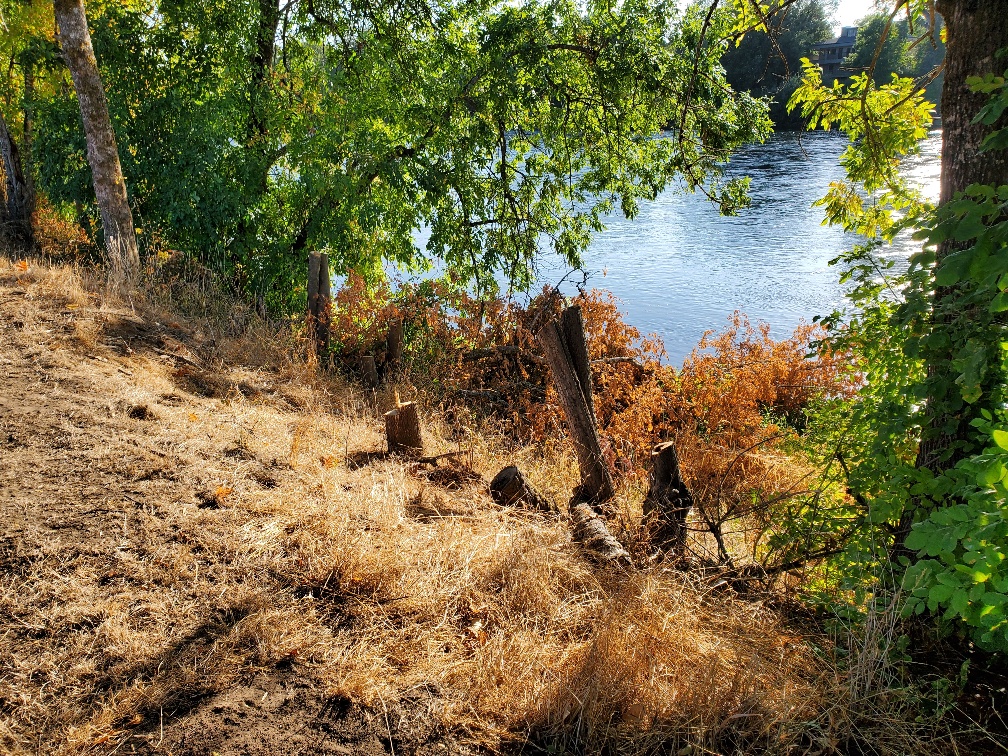
Willamette River Greenway Program – 48 Years Old: Concerns over trees and wildlife habitat along the Willamette River shouldn’t be a novel concept for either Trysting Tree managers or the OSU Foundation (which is the sole shareholder of the for-profit golf club). The concept of a scenic, protected, greenway corridor along the Willamette River was first laid out in the Oregon Governor’s race in 1966. In 1973, the Oregon legislature passed the Willamette River Greenway Act, allocating funds for local governments to purchase and protect land along the Willamette River. In 1975, Land Use Planning Goal 15 was enacted, requiring counties and cities to develop and implement rules governing the development of riverside land. Public access, native vegetation, and scenic views must be preserved when planning new developments.
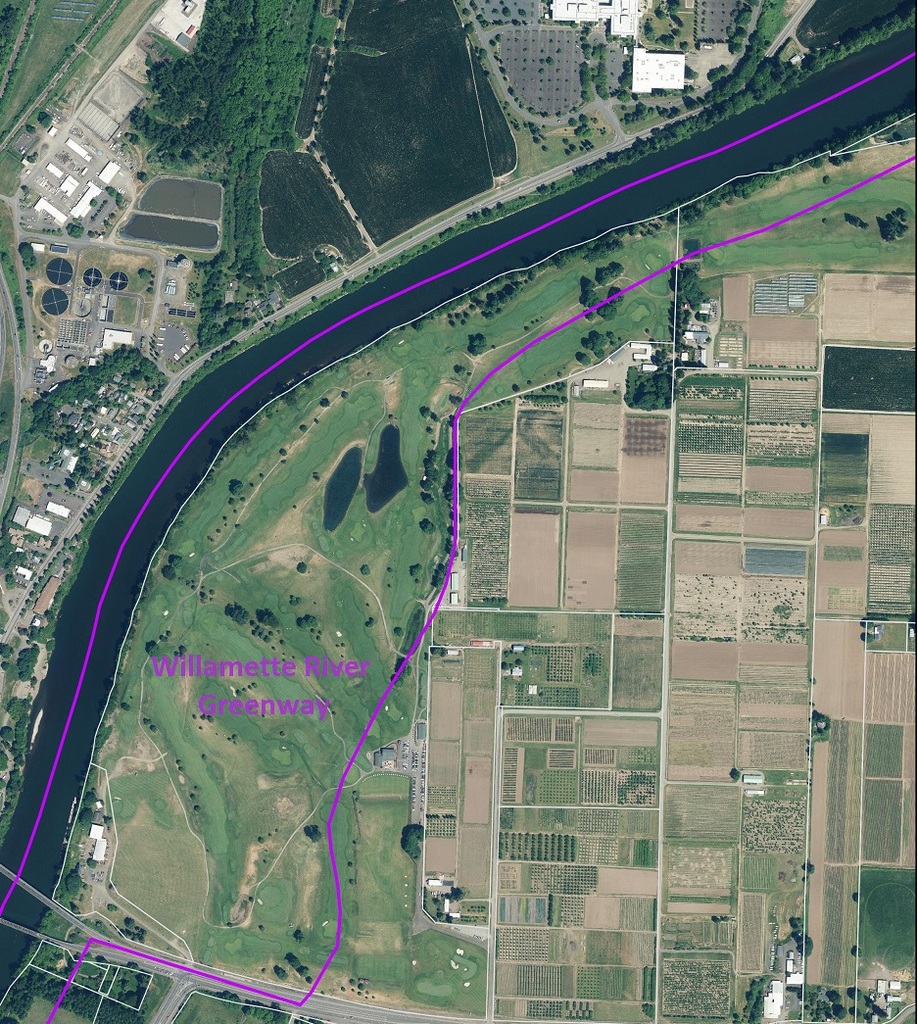
By the time OSU began planning the golf course in 1981, laws protecting the Willamette’s Greenway zone were well-established. Linn County officials had implemented specific criteria and a “Greenway development permit” governing all development within the river’s Greenway zone. The width of the Greenway zone varies, but generally extends a minimum of 150 feet from the ordinary low-water line of the Willamette River. In the case of Trysting Tree golf course, nearly all of the property falls within the Greenway. At its widest, it is more than 1600 feet (more than 10X the minimum buffer). This reflects the significant ecological value of the property before the course was built.
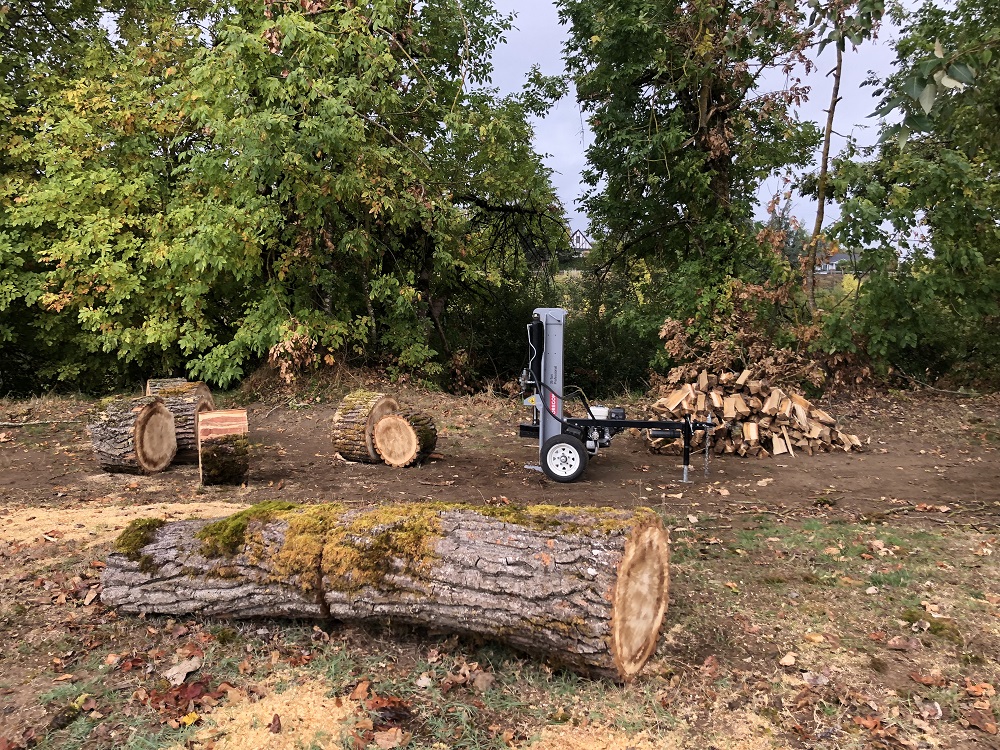
Greenway Conditions were Part of Permit for Golf Course: The OSU Foundation had to comply with the Willamette River Greenway conditions when it first applied for a development permit for the golf course in 1981. Linn County’s decision to issue a permit for the course was appealed and eventually ended up before the Oregon Court of Appeals. In its 1983 ruling, the Court reversed and remanded (sent back) the Land Use Board of Appeals’ (LUBA’s) affirmation of Linn County’s issuance of a conditional use permit and greenway development permit for the construction of the golf course [Oregon Court of Appeals, J.R. Golf Services, Inc. v. Linn County]. In basic terms, the Court of Appeals disagreed with how Linn County had applied its Greenway and development code in granting permission to develop the golf course.
In this notable defeat for the OSU Foundation, the Court of Appeals cited the following conditions (among others) of Linn County’s Greenway development code:
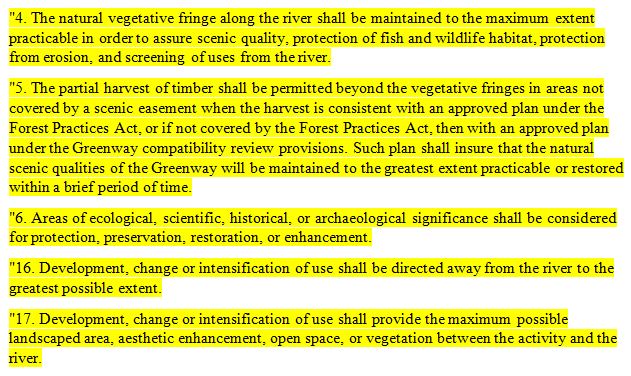
The OSU Foundation reapplied for a conditional use permit in 1984 and was granted approval by a 4-3 vote of the Linn County Planning Commission . It’s interesting to consider that the fate of OSU’s golf course plan was determined by just one vote. The 1984 Conditional Use Permit granting approval for the golf course also listed specific protections (in addition to the Willamette River Greenway restrictions):


I wonder what efforts were made to “re-establish the vegetative fringe along the Willamette River“? By cutting dozens of the largest trees, the OSU Foundation and Trysting Tree managers have diminished the natural features they were required to protect. One wonders whether the “teaching and research laboratory for students in…fisheries and wildlife” was ever provided. What lessons are students in forestry to take away from the destruction of these trees in violation of the Greenway protections?

Cutting Trees for “Public Safety” (and the River View): Trysting Tree board president, Mark Giustina (the third generation of Giustinas leading the company) disputes much of what Dr. Kauffman and Dr. Beschta have reported. In a recent Gazette Times article about the controversy, Mr. Giustina retreated behind a “public safety” defense. Giustina claims there have been “25 to 30 near misses in recent years” (i.e., falling tree limbs nearly hitting golfers). That seems like an extraordinary rate, given the relatively sparse spacing of trees and limited number of players. One wonders why he didn’t simply have an arborist trim the trees to remove dead branches – or cordon off the immediate vicinity of trees with caution tape. If lives were really at stake, preventive measures should be a first response (not simply cutting down the majestic trees). If safety was such a vital concern, why didn’t they make adjustments in the course layout when it was recently redesigned? And how do the OSU Foundation and Trysting Tree justify the cutting of trees on the riverbank? These trees were entirely within the river’s Greenway zone and posed no conceivable risk to golfers. The most plausible explanation is that course managers wanted to provide golfers with a better view of the river.

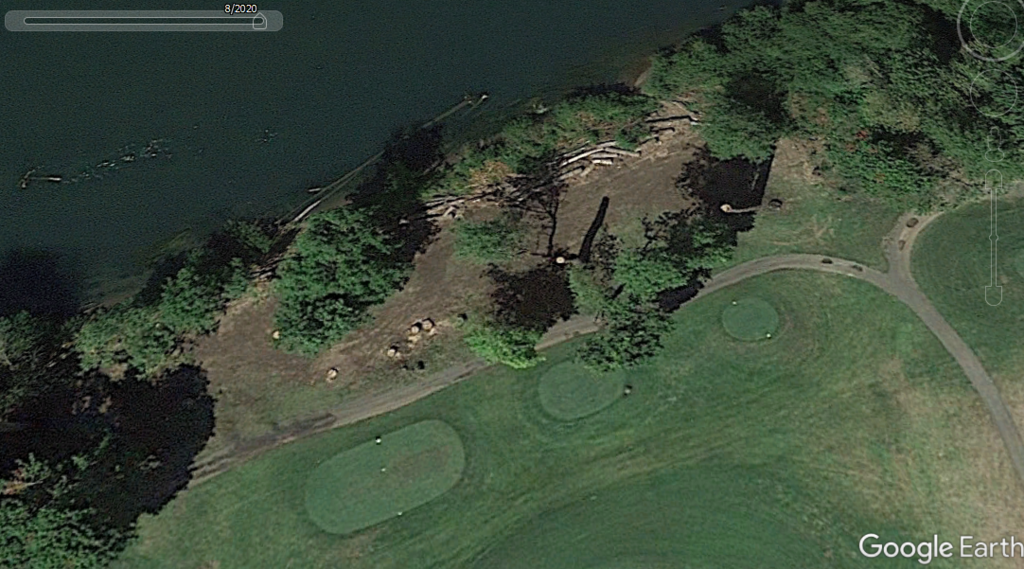
A Bigger Story Emerges: As I began to look deeper into this issue, several clues of a bigger story soon caught my attention. The Trysting Tree website makes no mention of their Board of Directors, nor does a Google search provide clarity. I emailed the Trysting Tree course manager, Sean Arey, more than a week ago asking about the Board of Directors – but have received no response. Dr. Beschta reported a similar pattern of non-response:
“Several times in the last month I tried to obtain information from Mr. Giustina about golf course operations and the Board of Directors to better understand how and why the destruction of their cottonwoods has come about. I asked for the names of individuals serving on the board to get their views. No response. I asked if there is a charter or other document that delineates what the board’s role is with respect to golf course operations. No response. I asked to see the 2020 and 2021 permits that supposedly approve the destruction of large cottonwoods along the Willamette River. No response. I asked for a copy of the arborist’s report that has been used by Mr. Giustina to justify large cottonwood removal. No response.” – (email from Dr. Robert Beschta).
Tax Records Reveal OSU Foundation Control: The lack of information concerning Trysting Tree’s Board of Directors led me to check the IRS tax records for the non-profit OSU Foundation. The tax forms show that the OSU Foundation is the “direct controlling entity” for its affiliate, Trysting Tree Golf Club Inc. As the sole shareholder of the for-profit golf course, the OSU Foundation determines the structure of the golf course’s Board of Directors – and chooses the board members. In short, the OSU Foundation’s Board of Trustees has overriding oversight responsibility for the golf course.

I emailed the OSU Foundation’s Trysting Tree liaison, Ms. Caron Ogg, asking who serves on the board of the golf club. Ms. Ogg has yet to respond. A person who phoned Ms. Ogg asking the same question was told to contact Mr. Giustina (the president of the golf course’s mysterious board). Clearly, the OSU Foundation is trying to erect a firewall between the Foundation and the growing controversy at the golf course. When will OSU leaders learn that evasive responses – or simply not responding – erodes their integrity and undermines public trust?
Money, Land & History Link OSU and Trysting Tree: OSU has a long history and deep financial ties connecting it to Trysting Tree golf course – and the Giustina family (who controls one of Oregon’s oldest timber companies, Giustina Land & Timber). A 2017 Oregon Stater article described some of these connections:
“A legendary OSU lumberman and philanthropist who died in 2005 at the age of 87, Nat Giustina provided the lead gift for the [golf] course and oversaw much of its construction…Nat’s son, Larry Giustina ’71, is chairman of the board that oversees the course…Philanthropy has always been at the core of Trysting Tree’s mission as an OSU Foundation affiliate. Profits from the course go back to the foundation to support various initiatives and programs at the university.
“To date we have given about $4.5 million back to the school since Trysting Tree opened,” [General Manager, Sean] Arey said…Proceeds have supported OSU’s turfgrass management program, the CH2M HILL Alumni Center, programs in agricultural sciences, business, engineering, music, the Valley Library and several athletic programs.”
With three generations of “lumbermen” controlling the golf course, I guess it shouldn’t surprise us that these majestic trees were cut (or that Giustina plans to replace the cottonwoods with Douglas firs). The Giustina family has been a big financial supporter of OSU’s College of Forestry (donating $3M for an endowed chair and substantial money for the College’s new forestry lab). With such strong ties, the Giustinas are as much a part of OSU as is Trysting Tree. Like a ‘Mother Tree’ with shared roots and mycorrhizal connections, the OSU Foundation has nurtured Trysting Tree and receives nutrients (money and support) in return. But unlike a ‘Mother Tree’, when problems arise, the OSU Foundation tries to distance itself.
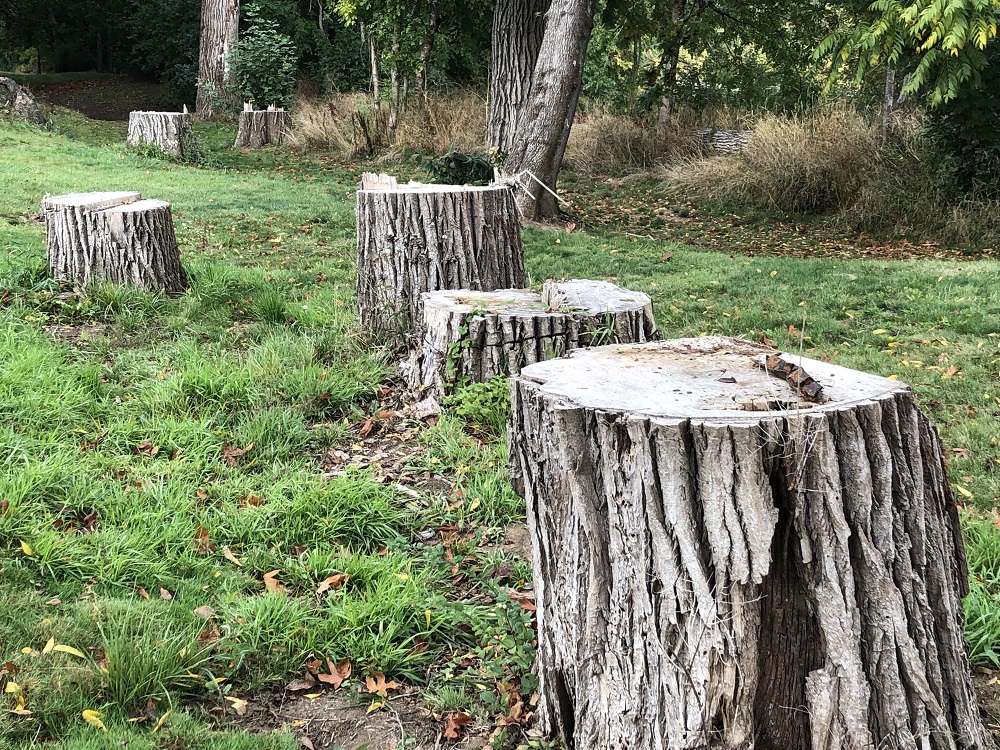
OSU Foundation Sidesteps Blame: The OSU Foundation’s position on the cutting of the trees was made clear in a recent email from the President and CEO, Shawn Scoville:
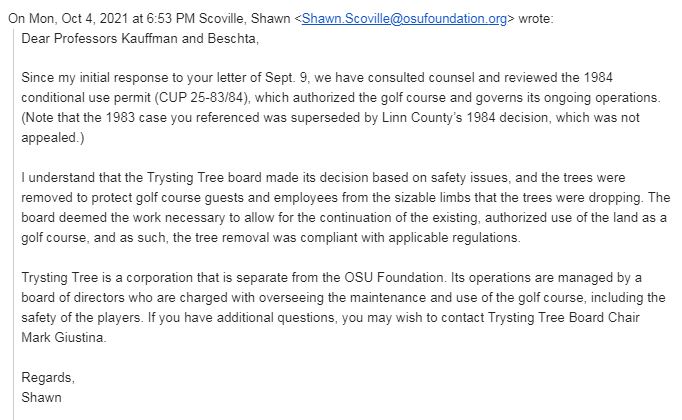
No apology has been offered, as that would imply responsibility on the part of the Foundation. Mr. Scoville has consulted their legal counsel and notes that the 1983 Court of Appeals case “was superseded by Linn County’s 1984 decision, which was not appealed.” The implication he seems to be making is that the Willamette Greenway protections cited in the 1983 case don’t apply. This is untrue. The “1984 decision” he’s referring to is the conditional use permit (CUP) granted (by the Linn Co. Planning Commission) to develop the golf course. The CUP did not waive Linn County’s Willamette River Greenway protections (shown near the top of this piece, high-lighted in yellow). Rather, the CUP stipulated additional measures to be followed.
In fact, the Greenway protections are ensured by a separate, but parallel permit process (i.e., a “Willamette River Greenway development permit”). I’ve asked the Linn Co. Planning Department for verification that OSU filed for the required Greenway development permits, but they have not responded. Permits should have been required both for the original course development and the recent tree cutting in the Greenway. Short of a blanket waiver (a very unlikely scenario), the OSU Foundation and golf course managers are legally required to abide by Linn County’s Greenway code and the conditions listed in their conditional use permit. Remember, the 1984 permit required them to, “re-establish the vegetative fringe along the Willamette River“, not destroy it!
Clearly, Mr. Scoville would like to distance the OSU Foundation from this public relations nightmare, while reinforcing the “public safety” defense. Rather than relying on counsel and using their misleading legal reference, Mr. Scoville ought to exert leadership and use common sense. He could start by educating himself about the history and intent of the Willamette River Greenway, one of our state’s ecological treasures. He could walk (or paddle) along the Greenway and see the damage firsthand. I’m sure the professors would be happy to lead him and his board on a personal tour.

Regaining Lost Trust: Instead of circling the wagons and sidestepping responsibility, the OSU Foundation should implement long-overdue changes in the management of their golf course. They could start by asking Trysting Tree managers to immediately halt the cutting of trees on the course. Transparency and accountability, including a full disclosure of the Trysting Tree Board of Directors, is a logical second step. Adding board members with ecological expertise (like Dr’s. Beschta and Kauffman) would show a sincere intent to change. Given the scale of damage and disregarding of repeated concerns, the OSU Foundation will need to take a much more assertive oversight role with the golf course.
The Foundation should also appoint an independent advisory group focused on ecological stewardship of OSU’s golf course property. This would include annual audits verifying compliance with Greenway protections and an ecological stewardship plan, with full disclosure to the public. What’s needed is a comprehensive, holistic approach that not only protects the fragile vegetative fringe, but restores the gallery forest and central slough that were largely destroyed by the construction of the course. The stewardship plan must also minimize pesticides, water usage, and the overall carbon footprint. OSU has the resources to become a leader in ecological golf course management, but does it have the will? With more $1 billion in assets and its extensive network of connections, the OSU Foundation could foster a solution that ensures safety and enhances the Greenway habitat. If OSU can propose raising more than $320 million for a stadium renovation, they can surely afford to protect critical riparian habitat on OSU property.
As they consider how to respond, OSU leaders need to keep in mind that this land and its natural features are public resources that belong to all Oregonians. With the golf course situated on OSU land, and OSU benefiting from the profits, the OSU Board of Trustees must acknowledge its oversight responsibility. As the cutting of old-growth in OSU’s Research Forests so dramatically illustrated in 2019, the University loses considerable public trust when it mismanages our public resources. We expect and deserve better than this from OSU, our university!

(photo courtesy of Travel Oregon)
***********************************************************************
How to Take Action: If you’d like to express your concerns about the cutting of these trees or the responses from the OSU Foundation, and the Trysting Tree Golf Club, you can contact the following individuals via email:
OSU Foundation Board of Trustees: OSUFoundation@osufoundation.org
Shawn Scoville (President and CEO, OSU Foundation): Shawn.Scoville@osufoundation.org
OSU Board of Trustees: trustees@oregonstate.edu
Becky Johnson (OSU Interim President): Becky.Johnson@oregonstate.edu
Mark Giustina (Trysting Tree Board President): mark@giustinaland.com
